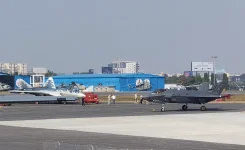- Views: 2K
- Replies: 9
Nagpur-based defence company JSR Dynamics Pvt. Ltd. has introduced a new weapon system, the Miniature Ground Launched Drone-Weaponized (MGLD-W).
This advanced missile drone, weighing 400 kg and launched from the ground, is designed for high-speed precision attacks. Powered by a 150 kgf turbojet engine, it can reach targets up to 297 kilometres away and travel at a maximum speed of Mach 0.85.
The MGLD-W is a relatively lightweight, autonomous aerial system built for flexibility in modern warfare. Its turbojet engine provides the necessary power for long-distance missions.
With its significant range of 297 km, the drone can strike targets well beyond the usual reach of ground artillery, providing a crucial advantage by allowing forces to operate from safer distances. Furthermore, its high speed, equivalent to roughly 1,050 kilometres per hour near sea level, enables quick responses to urgent threats.
Accurate navigation is achieved through a sophisticated system combining inertial navigation with multi-constellation Global Navigation Satellite System (GNSS) support. This includes access to signals from GPS, GLONASS, and India's own NavIC network, ensuring reliable guidance over long distances, even if enemy forces attempt to interfere with signals.
For the final attack phase, the MGLD-W uses advanced terminal guidance seekers, possibly employing imaging infrared or radar technology, to precisely hit specific targets, including those that are moving or heavily protected.
The drone is armed with an MK-81 type warhead, a standard 250-pound (approximately 113 kg) general-purpose bomb known for its reliable performance. While often dropped from aircraft, using the MK-81 in this ground-launched drone offers a potentially cost-effective way to deliver a significant impact.
This warhead can be adapted to explode with widespread fragmentation or to penetrate hardened structures, making the MGLD-W effective against various targets like military vehicles or fortified bunkers.
A key feature of the MGLD-W is its ground-launch capability. This allows it to be fired from mobile launchers, giving ground forces the ability to deploy it quickly without needing aircraft support. This flexibility is especially important for India, considering its varied geography and the need for effective standoff weapons along its borders.
The drone's 297 km range enables Indian forces to target valuable enemy assets, such as command centres, communication hubs, radar sites, or supply storage areas, while keeping launch crews safely away from most defensive threats.
The inclusion of terminal seekers greatly enhances the MGLD-W's effectiveness against moving or fleeting targets. Although exact details of the seekers haven't been released, similar Indian systems, such as the Rudram anti-radiation missiles developed by the DRDO, use advanced seekers to achieve high accuracy, often hitting within 10 metres of the target (Circular Error Probable - CEP).
If the MGLD-W achieves comparable performance, it represents a significant boost to India's indigenous precision strike capabilities.


